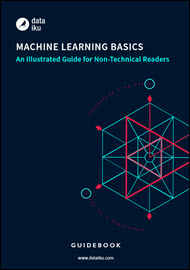Machine learning has become a water-cooler topic across industries. And the chatter about the possibilities of AI and deep learning certainly isn’t slowing down anytime soon.

Download the Full Report.
In an effort to reach non-technical readers, Dataiku has released a new report that offers a guide to machine learning basics. And no, you don’t have to be an AI expert to understand the content—complete with easy-to-understand diagrams and illustrations.
The report, “Machine Learning Basics: An Illustrated Guide for Non-Technical Readers,” starts out by exploring definitions of basic machine learning terms, including the topic itself. What is machine learning? Dataiku says it can be boiled down to one word: Algorithms.
[clickToTweet tweet=”Dataiku – What is machine learning? The answer is, in one word, algorithms.” quote=”Dataiku – What is machine learning? The answer is, in one word, algorithms.”]
To fully understand machine learning, one must have a basic understanding of data science concepts, as well. Next up, the report offers definitions of 10 fundamental terms for data science and machine learning. Think model, regression, classification and more.
Many businesses today use machine learning through tools such as prediction algorithms, of which the guide explores the most popular: linear models, tree-based models and neural networks.
A linear model uses a simple formula to find the “best fit” line through a set of data points. This methodology dates back over 200 years, and it has been used widely throughout statistics and machine learning.
But how do you evaluate these models? The guide has got you covered on that, as well. It includes metrics and methodologies for choosing the best model for your project. Dataiku breaks down evaluating models into three steps.
- Validation Step: The validation step is where you optimize the parameters for each algorithm you want to use.
- Test Step: The test step is where you take the best version of each algorithm and apply it to your test.
- Your Best Model: Based on the metrics you chose, you will be able to evaluate one algorithm against another and see which preformed best on your test set.
If you need any example, the report introduces the K-Fold Strategy and the Hold-Out Strategy, and compares the two popular methodologies.
Dataiku also touches on unsupervised learning, meaning “that we’re not trying to predict a variable; instead, we want to discover hidden patterns within our data that will let us to identify groups, or clusters, within that data,” according to the report.
If you reach the end of the report and still want more, Dataiku offers a variety of further resource options for future reading.
The full report from Dataiku covered the following topics:
- Machine Learning Concepts for Everyone
- An Introduction to Key Data Science Concepts
- Top Prediction Algorithms
- How to Evaluate Models
- Introducing the K-Fold Strategy and the Hold-Out Strategy
- K-Means Clustering Algorithms in Action
- For Further Exploration
- About Dataiku
Download the report, “Machine Learning Basics: An Illustrated Guide for Non-Technical Readers,” courtesy of Dataiku.




Just like you are saying Machine Learning and Artificial Intelligence both are water cooler topics nowadays but very few companies who are working tremendous in this area, But I don’t agree with AI and deep learning as you mentioned in your post. Day by day this topic also increasing. We heard that demand and supply rule when expert or companies think AI or Deep learning has potential then they will invest in it otherwise this language will vanish very soon.
Our team is working on artificial intelligence projects, It’s data science which is difficult to master for anyone. As companies like Amazon, Google, Yahoo working on AI products. Even non technical want to learn about AI development.
Machine Learning is certainly an interesting topic for me. I really enjoyed reading this blog. Thanks for sharing it with us!
Very interesting article. Thanks for sharing…